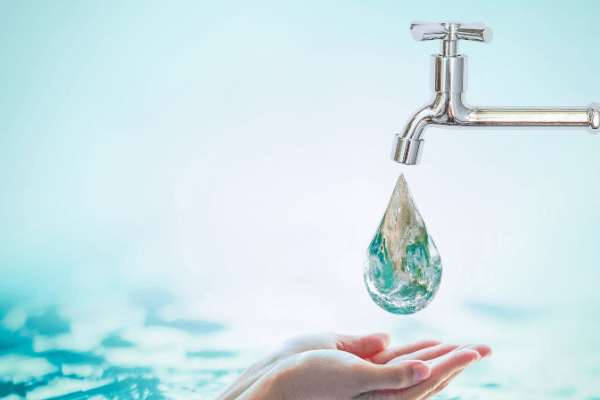Low-Flow Fixtures
Low-flow fixtures are designed to reduce water consumption in residential and commercial settings, significantly lowering water bills and greenhouse gas emissions associated with water heating and treatment.

Save water with low-flow fixtures (Firewood for Life)
job openings
View open jobs in this Solution
Example Companies
- Kohler - Produces a range of water-efficient fixtures for residential and commercial use.
- Moen - Offers innovative low-flow faucets and showerheads.
- Delta Faucet - Develops water-saving technologies for faucets and showerheads.
- TOTO - Specializes in high-efficiency toilets and faucets.
- Niagara Conservation - Provides ultra-high-efficiency toilets and showerheads.
Overview
Hot water is responsible for a quarter of residential energy use worldwide. More efficient fixtures and appliances can reduce home water use, thereby reducing emissions.
Learn More
Progress Made
Significant advancements have been made in developing low-flow fixtures:
- Low-Flow Showerheads, Toilets, and Faucets: These fixtures can reduce water use by up to 50%, leading to lower water bills and reduced greenhouse gas emissions.
- Technological Innovations: Improved aerators, pressure-compensating valves, and flow regulators enhance water efficiency without compromising performance.
Key organizations driving progress include:
- Environmental Protection Agency (EPA)
- WaterSense Program
- Alliance for Water Efficiency
Solutions by Sector
Residential
- Low-Flow Showerheads: Reduce water use while maintaining pressure.
- High-Efficiency Toilets: Use less water per flush compared to standard toilets.
- Water-Saving Faucets: Incorporate aerators to reduce flow without sacrificing performance.
Case Studies:
- Kohler's WaterSense Certified Products: Range of low-flow fixtures for homes (Kohler).
- Moen's Eco-Performance Showerheads: Designed to save water without compromising shower experience (Moen).
- Delta Faucet's H2Okinetic Technology: Provides the feeling of more water while using less (Delta Faucet).
Commercial
- Low-Flow Urinals: Use significantly less water per flush.
- Touchless Faucets: Reduce water waste in public restrooms.
- Water-Efficient Shower Systems: Designed for gyms, hotels, and other commercial facilities.
Case Studies:
- TOTO's High-Efficiency Toilets: Installed in commercial buildings to reduce water use (TOTO).
- Sloan Valve Company's Water-Efficient Fixtures: Provides a range of low-flow options for commercial restrooms (Sloan).
- Niagara Conservation's Ultra-High-Efficiency Products: Used in various commercial applications to save water (Niagara Conservation).
Industrial
- Process Water Efficiency: Implementing low-flow fixtures in industrial processes to reduce water consumption.
- Cooling Towers: Using water-efficient technologies to minimize water use in cooling systems.
- Irrigation Systems: Employing low-flow technology in industrial landscaping and agriculture.
Case Studies:
- GE's Water-Efficient Technologies: Applied in industrial settings to reduce water use (GE Water & Process Technologies).
- Xylem's Smart Water Solutions: Provides water-efficient technologies for industrial applications (Xylem).
- Hunter Industries' Low-Flow Irrigation: Used in industrial landscaping to conserve water (Hunter Industries).
Lessons Learned
- Water Savings: Significant water savings can incentivize adoption by lowering water bills and reducing emissions.
- Design and Installation: Proper design and installation are crucial for optimal performance.
- Public Awareness: Educating consumers on the benefits of low-flow fixtures is essential for widespread adoption.
- Economic Viability: Financial incentives such as rebates and tax breaks can encourage adoption.
Challenges Ahead
- Market Inefficiencies: Overcoming inefficiencies in the market to achieve optimal water savings.
- Awareness Gap: Raising public awareness about the ecological and climate benefits of low-flow fixtures.
- Incentives: Establishing financial motivations, like tax breaks or rebates, for individuals and businesses to adopt low-flow fixtures.
Leading organizations at the forefront of this cause include:
- WaterSense (EPA)
- Alliance for Water Efficiency
- International Association of Plumbing and Mechanical Officials (IAPMO)
Best Path Forward
- Increasing Awareness: Educational campaigns showcasing water and cost savings.
- Providing Incentives: Offering financial benefits like tax breaks or rebates.
- Enhancing Availability: Collaborating with manufacturers to boost production or accessibility through retailers and stores.
- Policy Support: Implementing regulations that mandate the use of low-flow fixtures in new buildings and renovations.
Image credit: Firewood for Life